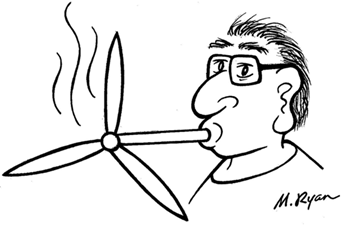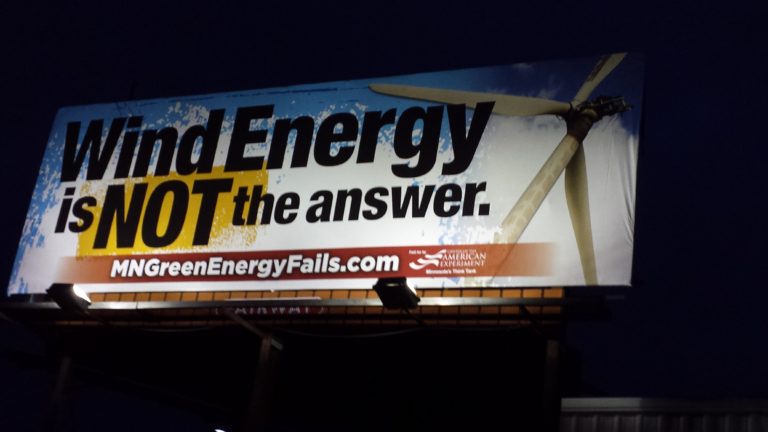Convoluted conflations don’t help…
April 21st, 2019

The Center of the American Experiment is at it again, dodging the legitimate issues and emphasizing the non-issues and flat out misrepresenting. It’s distractivism… Janna Swanson has it right in her STrib LTE:
It’s like the billboards CAE pasted across southern Minnesota, in the Freeborn Wind territory, going on about the “high cost of wind.”

That’s demonstrably false, which anyone involved in energy can see by the PPAs and overnight costs in any docket. Why were CAE’s costs inflated in their “study?” Because they included the PPA cost PLUS the overnight cost — really, read the study, the words and between the lines — that math doesn’t work.
What’s conflated about the Rosenquist/CAE piece below? What’s convoluted about the piece below? Simple: Causation and coal.
- It drives me crazy when people repeatedly use the word “cause” and “causation,” regarding in this case, wind noise, and in others, EMF. Yes, it’s a logical result of applicants who have promoted use of those words in utility administrative proceedings (“Dr.” Mark Roberts always submits testimony that causation is not proven, but why? Causation or not isn’t a siting criteria!), but it’s most unfortunate that so many have bought into this framing and spent good money on experts fighting this non-issue, in administrative permit proceedings and in district court eminent domain proceedings (i.e., the distractivism of the Cedar Summit focus on EMF diversion to causation, rather than reasonableness of concern, in an eminent domain proceeding, and despite expert witnesses and much discussion at the hearing, the judge was clear that causation was NOT an issue, see para. 15.). We ran up against that in every transmission docket, in every wind docket, and most recently, the Freeborn Wind docket. Earth to Mars, causation is NOT at issue in an administrative permitting docket — that’s NOT a personal injury suit! It is not helpful to go on and on about causation. Remember the tobacco cases — yes, that is a good comparison — because they’re so different. Those cases were tort cases, where causation is at issue — this is not. The two landowner families in Bent Tree were bought out after Commerce’s contracted noise studies showed probably “exceedences” of noise (notice how PUC staff also tries to frame it as causation issue?) over the state noise standards (Minn. R. 7030.0400) and the PUC approved the buy-out agreement. Causation is for tort actions — administrative permitting has zero to do with causation (click for explanatory link). Really… It’s that simple. This is why it’s important for an applicant to demonstrate that they can comply with the noise standards, and why in the Freeborn Wind docket, it’s a problem that the PUC is allowing them to avoid that public pre-construction review.
- Coal… S-C-I-E-N-C-E. DOH! Do some research before publishing something like this. Speaking in ignorance about coal and “black lung” (Thing of the past? Ask those suffering from it, those many who are still alive.) and the toxic nature coal mining and coal burning and the waste of both., not to mention overflowing coal impoundments, and the coal ash rule which tRump administration is gutting. Everyone in Minnesota should be aware of the mercury fish consumption restrictions/warnings for every body of water tested in Minnesota. Coal burning emissions include (consider any externalities docket), from the EIA:
ESeveral principal emissions result from coal combustion:
- Sulfur dioxide (SO2), which contributes to acid rain and respiratory illnesses
- Nitrogen oxides (NOx), which contribute to smog and respiratory illnesses
- Particulates, which contribute to smog, haze, and respiratory illnesses and lung disease
- Carbon dioxide (CO2), which is the primary greenhouse gas produced from burning fossil fuels (coal, oil, and natural gas)
- Mercury and other heavy metals, which have been linked to both neurological and developmental damage in humans and other animals
- Fly ash and bottom ash, which are residues created when power plants burn coal
So, here we go… Kristi Rosenquist in a Center for the American Experiment post:
Guest Column: ‘Wind Turbine Cancer’ – Is President Donald Trump Crazy? Maybe Not.
Energy, Environment on April 18, 2019 Print
The following article is a guest column by Kristi Rosenquist, a Grassroots Citizen Activist in Minnesota:
When President Trump said, “The noise [from wind turbines] causes cancer,” the reactions were immediate. Iowa Senator Chuck Grassley called Trump’s statement “idiotic.” Democratic Presidential candidate and Vermont Senator Bernie Sanders mocked Trump in a Bernie 2020 video – standing alongside a road in Iowa with wind turbines in the background. And, no discussion of wind energy, no matter how minor, would be complete without the comparison to “dirty coal:” “A power source that does cause many health problems, including cancer, is coal, an extremely dirty fuel…,” Said Jonathan Chait of New York Magazine.
Thousands of rural residents with direct knowledge and experience with wind turbines had a different response. Rural Iowa resident Janna Swanson, President of the Coalition for Rural Property Rights, expressed what I saw as the most common reaction – matching my initial reaction – in her response published in the StarTribune (but not in the Des Moines Register to which she also submitted).
“If President Trump said that industrial wind turbines cause cancer, that is unfortunate, because it downplays the real negative impacts that do come with living next to or within an industrial wind installation.
Rural residents the world over have complained of headache, vertigo, dizziness, sleeplessness, chest tightness and tinnitus from turbines being sited too close to their homes. In contracts wind companies … freely admit that turbines can …“cause or emit noise, vibration, air turbulence, wake, and electromagnetic and frequency interference.”
On further reflection, I think Trump was only partially wrong by using one very important word – “cause.” What turbine noise does most consistently “cause” in rural communities across the globe is sleep deprivation. What does sleep deprivation cause?
“…The extensive and longstanding peer reviewed published clinical research detail[s] the known interconnections and associations between chronic sleep deprivation, … [and] immune suppression resulting in increased …malignancies (cancers)…. [Observation of these] health problems worsening with exposure to wind turbine noise is not surprising to clinicians …when they understand the way infrasound and low frequency noise ….are known to affect health….” Testimony to the Appeals Tribunal of the State of Victoria, Australia by Dr. Sarah Laurie, MD.
Getting enough sleep is important for overall health and may be related to cancer risk:
“From a biological perspective, there are a lot of good reasons for us to suspect that insufficient sleep, chronic sleep debt or short sleep duration could have an impact on the development of cancer….” Amanda Phipps, an epidemiologist and researcher at Fred Hutchinson Cancer Research Center in Seattle quoted in U.S. News and World Report.
The Minnesota Department of Health (MDH) has been quite clear and consistent in their statements to the Minnesota Public Utilities Commission (PUC) about wind turbine noise and health. In turn, the PUC has been quite consistent in ignoring MDH’s advice as they issue “certificates of need” and “site permits” to industrial wind complexes in Minnesota.
“…It is unknown whether reported health impacts are direct health effects or indirect stress impacts from annoyance and/or lack of sleep resulting from turbine noise….” “…Health impacts from wind turbine projects should be acknowledged, and provision should be made to mitigate these effects for residents within and near proposed project areas.” (PUC Document ID: 20176-132804-03; pages 59-61)
“…Low frequency [wind turbine] noise is primarily a problem …in …homes, especially at night.” “The most common complaints are sleeplessness and headache.” “The Minnesota nighttime standard …appears to underweight penetration of low frequency noise into dwellings.” The PUC should “…evaluate the low frequency noise component.”Public Health Impacts of Wind Turbines 5/22/2009.
In 2016, when I and other citizens met with MDH Commission Ed Ehlinger to discuss the negative health impacts of wind turbines, one of the other citizens said that the wind industry acts a lot like ‘Big Tobacco.’ Both the tobacco industry (in the past) and the wind industry deny their product causes any health problems thereby forcing sick people to individually attempt the very expensive and very high legal bar of proving “medical causation.” Ehlinger agreed that’s “a good comparison.”
I asked Ehlinger, “How many reports of people sick from wind turbines do you need to receive at MDH before you are obligated to act?” He responded, “I’m never obligated to act unless forced to do so by the Governor or the legislature.” I notice that Ehlinger was forced to resign when he failed to act on thousands of reports of neglect and abuse in Minnesota care facilities.
I can’t find a clear distinction between Senator Grassley’s position on industrial wind energy and that contained in Alexandria Ocasio-Cortez’s Green New Deal – their stated motivations are different, but their policy proposals look similar. August 7, 2018 was a busy day for Grassley with two Townhall meetings that both featured discussion of Iowans opposed to wind energy, and a private photo-op with Alliant Energy and the American Wind Energy Association to receive AWEA’s ‘Wind Champion Award.’
I notice they didn’t hold the Wind Champion Award ceremony at Alliant’s Bent Tree Wind project – where Alliant had just finalized the buy-out of Minnesotan’s homes that are no-longer inhabitable due to wind turbine noise. Bernie and Cheryl Hagen are just one sample of people who;s home was bought by Alliant energy after years of sleep deprivation and low-frequency noise after the Bent Tree Wind facility began operation (MN PUC docket ID 08-573).
Bernie Sanders apparently failed to notice the significant wide-spread hatred of wind turbines in rural Vermont that resulted in a significant noise limitation in Vermont’s wind turbine siting rules in 2017.
Mark me ‘Safe from coal cancer,” Jonathan Chait. I’m not a coal miner. The only coal cancer I’m aware of might be from coal miners without sufficient respiratory protection. I thought “black lung” was a thing of the past? Union of Concerned Scientists claim coal plants cause cancer through emitting arsenic that gets into drinking water in concentrations high enough to cause cancer…. I think if that claim had any medically provable credibility, one of the well-funded faux-environmental coal-hate groups would already have successfully sued a coal-fired power plant that “caused” arsenic cancer.
Perhaps Grassley, Sanders, and Chait believe that rural residents are suffering from a “global hallucination event.” The Minnesota Legislative Energy Commission held a hearing on wind energy and health. I asked expert witness Dr. Mariana Alves-Pereira what she thought about wind developers’ repeated assertions to the Minnesota Public Utilities Commission that their turbines don’t cause the health problems that people report. Dr. Alves-Pereira said, “Unless everybody’s going through a collective hallucination around the world, I don’t see how that statement can be upheld scientifically.” (Oct. 19, 2017 audio; Dr. Alves Pereira testimony starts at 23 minutes)
I think Sherri Lange, CEO of the North American Platform Against Wind Power, sums this up beautifully:
- Do stress and lack of sleep contribute to the development of cancer? Yes.
- Does wind turbine noise raise stress levels and interrupt sleep? Yes.
April 21st, 2019 at 6:48 pm
Great piece of writing, and explanation. Shortly to follow, will be some research by Dr. Sarah Laurie. I believe she will be writing her own post on this, and friends, we can be absolutely sure that the evidence is in, and that we can not feel as outliers by talking about the C question. It is one of the diseases caused, or possibly caused, sorry to get into causation, by sleep disruption of a chronic nature. Which we KNOW is the result for many living too near turbines. Thanks to Janna and Kristi….and this blog! Very good to have the discussion.